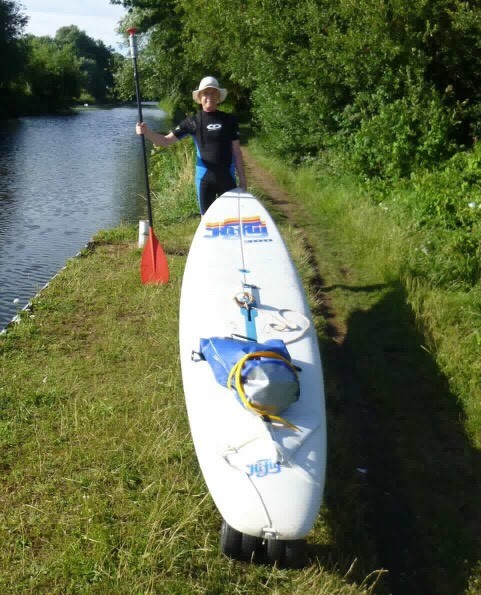
Stand up paddleboarding is about the journey: at any point you may choose a more challenging path and start racing or just carry on, gliding, discovering, embracing nature, finding peace and yourself. The most unexpected part of this experience is people. Meeting like-minded souls along the way, high on the same stoke. We met Brian Farley by chance. We started talking about paddleboarding and the HiFly windsurfing brand came up. My dad was a keen windsurfer in the 80s and owned one. I loved the bold logo and colours of the sail. I remember being a part of the windsurfer pack back then. Together with other kids, we were helping our dads with the equipment in exchange for rides. Brian’s story really struck a chord with me and I’m super grateful to share it with the SUP community.
Please tell us a little bit about yourself…
I’m a retired electronic engineer, age 75, and worked all my life in Nortel Networks research laboratory at Harlow, England – where fibre optic communication was born. My job was research into radio and cable communication design. After my studies, I left Scotland for England to marry my wife who lived near London. We met Youth Hostelling in the Isle of Man and shared a love of the outdoors, especially in Scotland. To hear a BBC radio interview of my life, just google “Woman’s Hour Brian Farley” and play the second interview at 9min 34sec. As her brother also met his wife youth hostelling, her family told me that the YHA stood for “Your Husband Assured”.
When did your SUP adventure begin?
It really started with “windsurfing” in lakes in the late 80s, using a HiFly300 sailboard – 12’8”x28”, 240 litres volume, and 19 kg weight. My treasured memory is sailing down Ullswater in the Lake District in such beautiful scenery and overtaking a Laser dingy. But as my caring duties for my wife with MS grew, my sailboard was left hanging up in my garage.
Then, about the time my wife died in 2012, I saw a countryside TV presenter on a SUP board in the Norfolk Broads. Wow, that was it – my old SUP board was the right size! So I got a paddle and dry bag and took off on my own, on my local river Stort – a happy bunny in deck shoes for grip. And I stayed rooted to the spot where I stood, to be stable – no racing turns on that board. I spent 5 years paddling on my own and was delighted to come across the Cambridge group SUPer Whale one day. It’s fun to go out with them and Anna introduced me to the Yster SUP brand.
What’s so special about SUP to you?
It’s peaceful just cruising along, and I get such a good view from being high above the water. I feel more stable on a SUP than in a kayak – kayaks and narrow canoes easily roll over. And as I’ve injured my back in the past, it’s more comfortable standing up than sitting down. I like being with others, and talk as we paddle, but I tend to talk too much. I often joke to others that “Nothing Stops me Talking – I even opt for local anaesthetic so I can talk during surgery”. For hours, seriously!
What are your favourite SUP locations?
My local rivers, the Cam and the Ouse, are lovely – and it’s fun on the Cambridge college backs. Mind you, I’ve been knocked off from behind by both a one-man scull (no rear view mirror) and a punt (no reverse gear). I also like the Thames around Reading and Henley, and once took a diversion into the Kennet and Avon Canal through the Oracle shopping centre. That surprised some people.
What are the challenges of the sport?
Although I like going fast, I’m not fast enough for racing. I’m really a tourist and would need a paddling partner for longer one-way trips using two cars. I don’t find SUP a challenge as it feels as natural as walking. I just stay in my comfort zone, probably because I’m older now.
Why Yster SUP brand?
Quality, quality, quality – I knew I had to have one. Yster hard boards just grabbed my heart as I’m a perfectionist, and they were so beautiful and polished. What more can I say, except that getting a more stable board than my old sailboard made SUP more of a pleasure. I didn’t really want to go from 28” to 30” width, but that’s a compromise I made as I preferred the deep teal colour of the wood front 12’8”x30” to the powder blue 12’8”x29″ all wood. It glides so smoothly, and I could probably sleep on it in flat water. I advise everybody to get the 10” straight line tracking fin with a shallow leading edge. It doesn’t pick up weeds and its large area makes manoeuvering easier – it helps keep the back of the SUP where it is, when the front is pulled around.
What’s next for you and your SUP adventure?
The Lake District is still on my bucket list, and the west coast of Scotland would be a dream. But as I’m useless in rough water, I’d choose Loch Lomond and other inland lochs. The Great Glen would also be a great adventure, but Loch Ness can be very windy and choppy, and it’s a long distance. A support crew with tent is needed for that. Anyway, I’m not keen on driving long distances on my own now.
To join Brian during SUPer Whale social paddles, visit our Facebook page and follow our social events.

